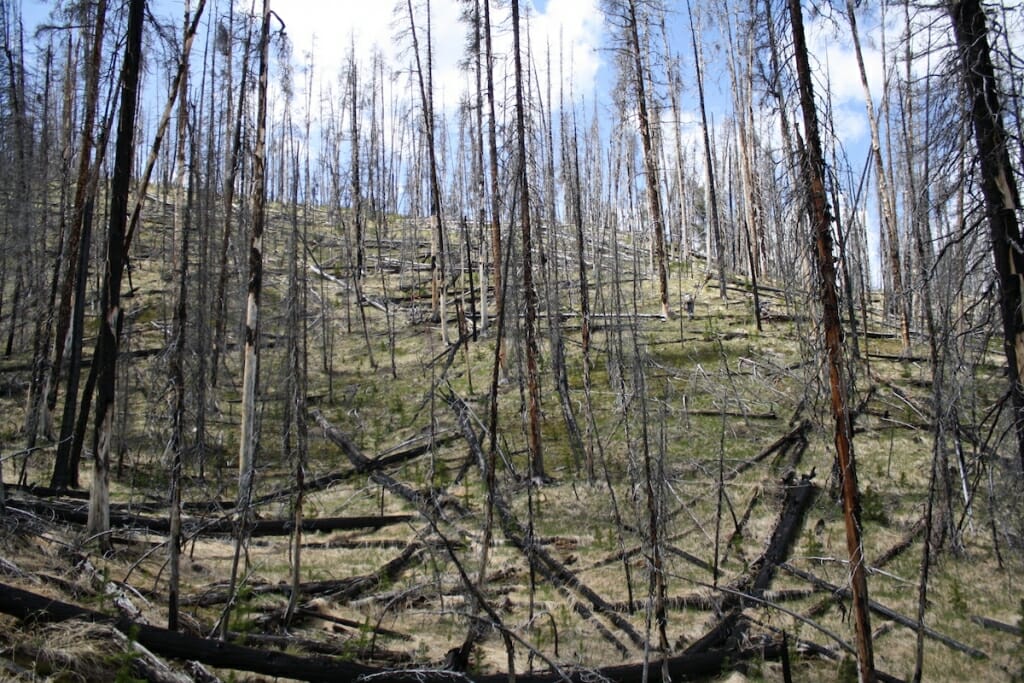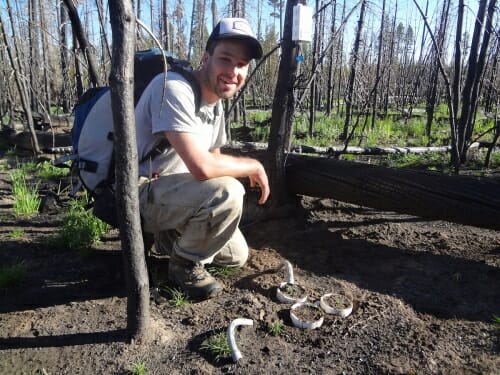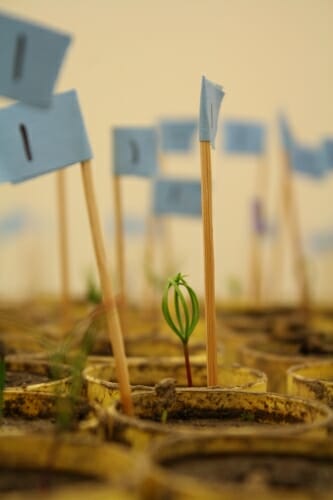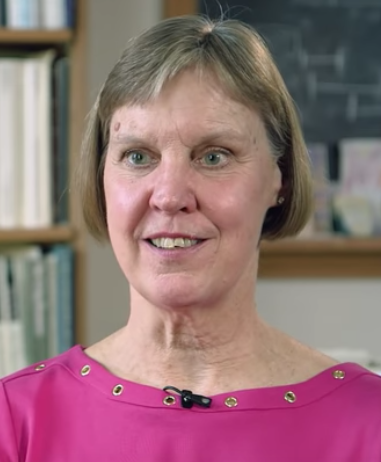With fire, warming and drought, Yellowstone forests could be grassland by mid-century

For a study looking at the ability of trees in Yellowstone National Park to recover from fire under climate conditions that are warmer and drier than they have been historically, researcher Winslow Hansen planted tree seeds in soils from areas of the park like this one, which recently burned. Photo: Ann K. Olsson
The fires in Yellowstone National Park began to burn in June 1988. A natural feature of the landscape, park managers expected the fires to fizzle out by July, when rains historically drenched the forests and valleys of the world’s first national park.
But the rains never came. Unusually hot, dry and windy that year, more fires erupted and blazed in and around the park until September. By then, 36 percent of Yellowstone was affected. Firefighting efforts topped $120 million.
Yellowstone experiences large fires every 100 to 300 years and its flora and fauna are adapted. Lodgepole pines like those at higher elevations in the park have pine cones that open in fire, releasing seeds to replenish a post-burn forest. But it takes time for trees to mature and the forests to recover — time that a changing climate has been depriving the forest of the last three decades.

Researcher Winslow Hansen checks on one of his study plots at Yellowstone National Park. Hansen was studying whether trees will be able to regenerate after forest fires in the park given projections for a warmer and drier climate. Photo: Monica Turner
A new study published today [Jan. 17, 2019] in Ecological Monographs, led by Winslow Hansen and his former graduate advisor, University of Wisconsin–Madison Professor of Integrative Biology Monica Turner, shows that some of Yellowstone’s forests may now be at a tipping point. They could be replaced by grassland by the middle of this century.
“It’s terrifying in some ways,” Turner says. “We are not talking many years away. Today’s college students will be mid-career. It feels like the future is coming at us fast.”
Though Turner’s work in Yellowstone across the last 30 years has helped us better understand the resilience of the forests, and aided land managers planning for the future, Hansen became interested in whether the forests could keep pace with climate projections.
Large fires are no longer a rarity in the West, and already, Yellowstone is nearly 2 degrees Fahrenheit warmer on average than it was just 60 years ago. The park’s forests may be at the brink of abrupt change, where their resilience may suddenly be overwhelmed.
“Fires are being driven by hot, dry conditions and these are trends that are expected to continue,” says Hansen, now an Earth Institute Postdoctoral Fellow at Columbia University. “We need answers now to better anticipate future change.”
To achieve this, he and Turner carefully picked sites in Yellowstone to determine how well tree seedlings can establish in warmer, drier conditions like those predicted for mid-century, based on the International Panel on Climate Change Fourth Assessment Report. Right now, lower elevations of the park provide a natural simulation of these projections.
“We found places on the landscape where today’s climate is representative of what we expect to see in subalpine forests 50 years from now,” explains Hansen. They also included sites in recently burned forests at higher elevations as controls.
“It’s terrifying in some ways,” Turner says. “We are not talking many years away. Today’s college students will be mid-career. It feels like the future is coming at us fast.”
Hansen collected soils from two recently burned areas, analyzed the soils for qualities like texture and pH, and then placed them in the ground at the low- and high-elevation study sites. He also installed sensors to collect hourly data on soil surface temperature and moisture and planted hand-collected, local Douglas fir and lodgepole pine seeds in each patch of soil at the study plots. Over a three-year span, he measured the number and height of the tree seedlings that grew and survived.
Douglas fir trees are better adapted than lodgepole pine to grow in dry, warm soils and are more often found at lower elevations. However, the study found that seedlings of both tree species only established and survived in high-elevation plots, where temperatures at the soil surface were between 52.5 and 59 degrees Fahrenheit. At low-elevation study plots, soil temperatures regularly exceeded this range and the soils dried. Up to 92 percent of the seeds never established and those that did died within three years.
“It wasn’t just a small reduction,” says Turner, “it was a failure to establish at the lower elevations.”

Tree seedlings grow on the University of Wisconsin–Madison campus in the Biotron — an environmentally-controlled facility calibrated to mimic a changing climate. Photo: Ann K. Olsson
In a separate experiment, Hansen hauled soils from the same post-fire areas of the park back to Madison, Wisconsin, and potted them inside a facility on campus called the Biotron that can recreate virtually any environment on the planet. He wanted to identify more precisely which combinations of temperature and soil moisture affect tree seedling establishment after fire.
In each room, he simulated the growing seasons of the early 20th century, the mid-21st century, and the late 21st century through 2080, which ranged from relatively moist to drought-like and warm. After weeks of planning, he and his wife, Ann Olsson, spent 19 straight hours setting up the rooms.
“It took an enormous amount of effort to calibrate,” says Turner.
Every four days, with undergraduate assistant Ryan Fitzsimmons, Hansen hand watered the seeds in all 1,000 pots. Every two to three weeks, they measured seedling emergence, height and mortality.
Though they had not planned for it, the soil temperatures in the Biotron were up to 10 degrees Fahrenheit cooler than those in the field, primarily because the soil samples in the field were insulated by surrounding soils. Incidentally, this allowed them to examine how both tree species responded to conditions similar to the high elevation regions of Yellowstone today.
“At the time, it felt disastrous,” says Hansen, but the Biotron experiment showed that seedlings emerged only when soils met a minimum warm temperature and that future warming could actually enhance post-fire regeneration at higher elevations.
The study captured the entire range of growing season temperatures at which seedling establishment reliably occurs and found that projected mid-century temperatures fall well outside that range.
“This is pretty concerning if we expect to have reliable tree regeneration in the future across much of Yellowstone,” says Hansen.
As an ecologist, he understands landscapes and ecosystems are dynamic; he’s wary of making a value judgement. Yet, Hansen grew up near Yellowstone and got his start in ecology observing forest songbirds around the park. He is concerned for the future of the area.
“Forests are critical from both social and ecological perspectives,” he says. “The Greater Yellowstone region may be a very different place to live and visit over the next few decades.”
“Fires are being driven by hot, dry conditions and these are trends that are expected to continue,” says Hansen. “We need answers now to better anticipate future change.”
Some species will adapt and others will not, says Turner, who at 19 worked as a ranger in the park. As plant communities change, so too will the animals.
Her research group continues to work toward a better understanding of the thresholds that underlie profound change. They are now also using sophisticated models to try to get ahead of it, including the findings from Hansen’s study.
“Experiments help you nail a part of the mechanism but you also need field observations and computer simulations to explore a range of conditions you can’t do in the field,” says Turner. “With a threshold, the best way to know you’re there is to cross over it.”
But we may not like what’s on the other side, she says. These changes are likely to be more significant than people realize. We must get better at predicting them. “We can’t wait for decades.”
The study was funded by the National Science Foundation (DGE-1242789, DEB-1600716), the Joint Fire Science Program (16-3-01-4) and the University of Wisconsin–Madison Vilas Research Trust. doi: 10.1002/ecm.1340





